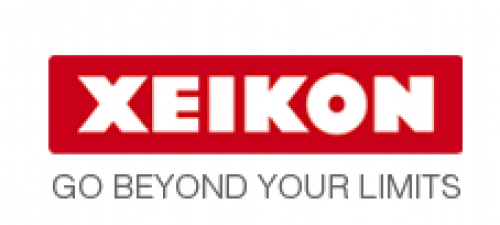The company introduced its new solution for industrial heat transfer applications for tubes at the expo. Delivering 1200 dpi image quality and with just-in-time delivery in mind, the new Xeikon and MOSS collaborative solution offers the perfect alternative to direct printing and in-mould label technologies, techniques traditionally used for decorating plastic containers of industrial goods.
The new thermal label transfer solution is unique to the Xeikon 3000 Series of digital presses, opening up new business opportunities for label printers. Developed in conjunction with their partners, MOSS of Italy, the heat transfer solution meets the growing demand from brand owners for higher quality decoration and wider versioning capabilities, whilst also embodying smaller runs per version.
Buckets and Tubes and other similar containers made from a range of plastics including polypropylene (PP) and high density polyethylene (HDPE) can now be decorated with high impact full colour graphics and the Xeikon printing system delivers crisp, sharp images and text for maximum shelf impact.
Traditional decoration techniques used for industrial goods such as direct printing are now struggling to meet the image quality levels demanded by the modern 21ast century marketers, said Filip Weymans, Marketing & Business Development Manager, Labels & Packaging at Xeikon.
In-mould label technology scores well on the quality front, but because the decoration has to be applied when the containers are moulded, it’s better suited to higher volume production, with the serious disadvantage of longer lead times and higher setup and make-ready costs. Our Xeikon-based solution now enables producers to offer their clients the best of both worlds – superior image quality for greater shelf impact and far more flexibility to decorate containers on a just-in-time basis. This opens up further business opportunities for label printers to start converting business away from the direct printing market into the label market.
The unique technique developed jointly by Xeikon and MOSS which uses heat transfer is a two-step process – firstly, Xeikons digital press prints the exact number of full colour heat-transfer labels as a pre-printed roll. The roll of printed transfer labels is then fed into a MOSS applicator which applies the label directly onto the container using heat and/or pressure. The new heat transfer technology supports four interesting and innovative transfer processes: industrial transfers, promotional transfers, textile transfers and waterslide transfers.
Industrial transfers are used primarily for the decoration of consumer goods packed into solid-sided plastic containers such as seamless tubes, buckets, cartridges, etc. – up until now, these have mainly been decorated using direct screen, direct offset, SA-labels or in-mould label (IML) techniques.
Being older technologies, these direct printing techniques often do not offer the print resolution needed to create high quality graphics. Set-up and change-over times can also take several hours so they don’t offer the flexibility being demanded by the market today. SA-labels provide a great flexibility but represent a higher cost in decoration based on the label material and very often the application is done manually, which is expensive and time-consuming. In-mould labeling or IML, on the other hand, does deliver very high image quality, but the decoration has to be applied when the container is created, so Labels need to be produced beforehand and stored, making the time to market relatively long, whilst increasing stock-holding costs for the plastics producers unnecessarily.
The heat transfer solution overcomes all of these shortcomings. Its superb high-definition image quality and smooth vignettes delivers photorealistic high impact decoration. Xeikons dry toner technology, which lies at the heart of the solution, also ensures the characteristics of the toner remain stable, guaranteeing colour strength and excellent light fastness even over time.
The companys unique one-pass opaque white capability further ensures proper colour reproduction on tinted containers. Decoration can be applied at any stage in the supply chain prior to the filling process, allowing maximum flexibility for the marketing departments wanting to react at short notice to new consumer demands.









